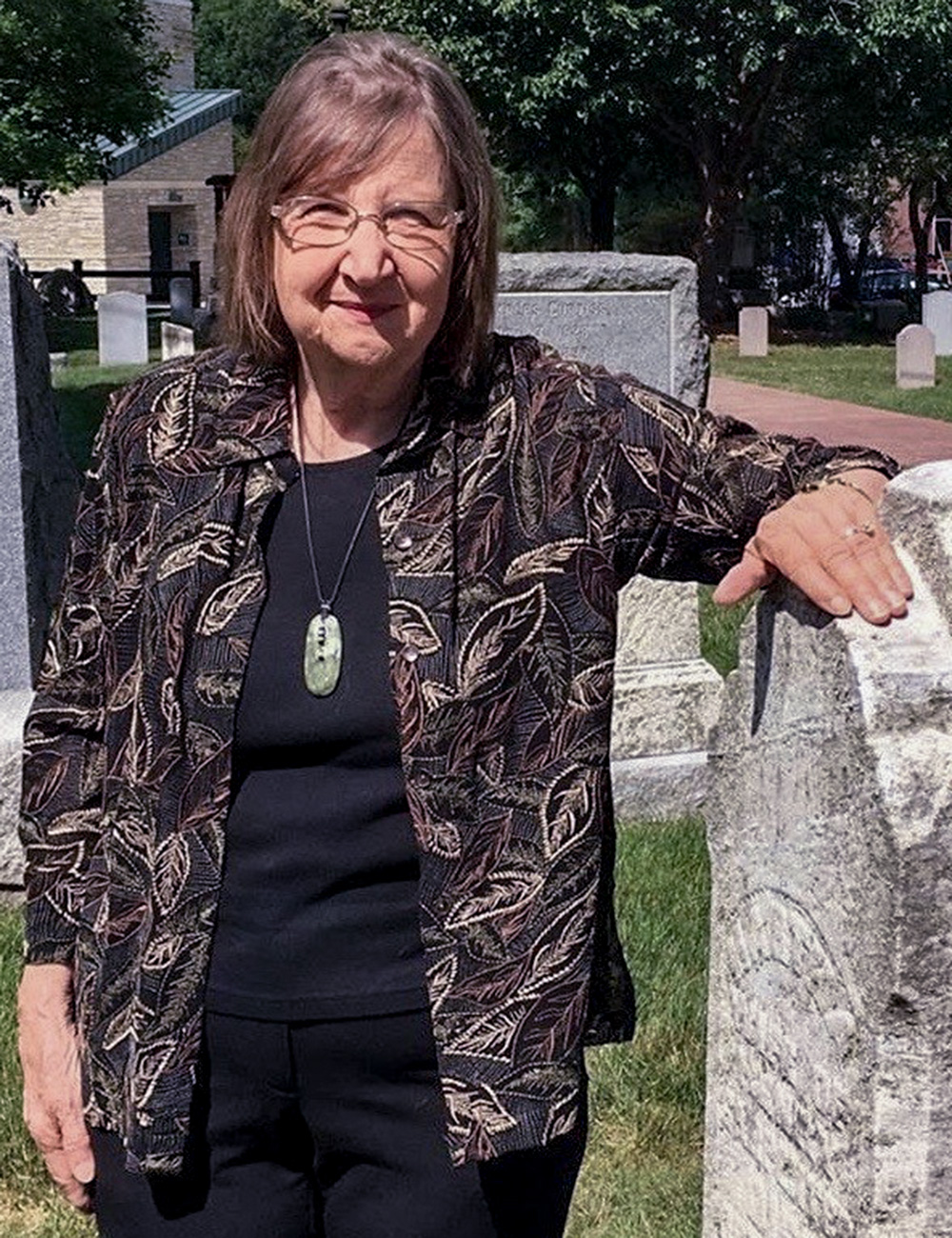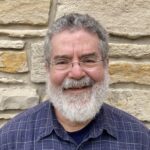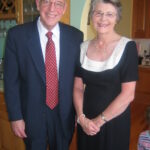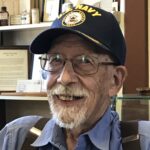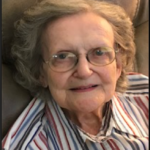They have “appeared” in Downers Grove’s notable Main Street Cemetery just once a year in the fall for several years now, although their graves are there year-round. “They” are some of the early settlers of the village, present through being portrayed by a variety of volunteers, most of whom have been Herrick Middle School students from Marilyn Ludwig’s Drama Club.
Ludwig, a beloved Downers Grove teacher, author, director, and historian, has coached students in “bringing to life” many of the cemetery residents for the past seven years as part of the Downers Grove Historical Society’s Living Cemetery event.
Her work related to it is one of the main reasons she has been chosen for the Downers Grove Historical Society’s 2021 Historian of the Year, an honor she richly deserves, according to Society President Liz Chalberg and the Living Cemetery event coordinator, Lois Sterba, along with the rest of the award committee.
“The Historian of the Year Award was created in 2013 to recognize those who have significantly promoted and preserved Downers Grove History,” Chalberg commented. “Marilyn, who is a member of the Historical Society, has impressively met these criteria mainly by faithfully providing a wonderful cast of young people for the cemetery portrayals for seven years now,” Chalberg said.
“Her students have done a wonderful job,” Sterba added; “they complimented the efforts of the adults involved because Marilyn prepared them so carefully.”
Ludwig, a former teacher with a theater background, was able to combine her education and drama interests at Herrick. There, the after-school theater program she directed ran for thirty years.
Her theater experience also includes her being a long-time member of the village’s community theater, Grove Players, where she has directed, produced plays and worked behind the scenes. She also has served on numerous play reading committees and on the Grove Players Board as president and as executive producer.
Ludwig and her family have lived in Downers Grove for almost fifty years now, so she has personally witnessed and participated in close to half a century of the town’s history. With her involvement in the Living Cemetery event, she has learned and shared more about the town’s much earlier history.
Ludwig learned of the Living Cemetery event in 2013 and thought it notable on several counts. The costuming worn and the portrayals presented by the volunteer reenactors representing some of those buried in the Main Street Cemetery are both informative and entertaining. In addition, that cemetery is one of just a few in the entire country still in existence on a town’s main street. As a result, it is a much-visited and appreciated landmark in downtown Downers Grove.
The Living Cemetery program, begun in 2012, initially used several volunteers from Grove Players to enact the roles of some of the key early settlers buried there. When the theater company had some trouble coming up with the number of actors needed one year, Sterba reached out to Herrick for help. She was told about Ludwig, whom she contacted to see if any of her students might be interested in being involved in the cemetery event.
They were – and “the rest is history.” Sterba provided Ludwig with the names of the early settlers whose lives could be covered and information about them. Much of that information is available in “Voices That Are Gone,” a guide to the cemetery that was written by Historical Society members Phyllis Betenia, Montrew Dunham, and Carol Wandschneider in 2005, and to which Sterba has since added additional information.
Ludwig made that research material available to her students early each fall so those willing to participate had time to review the information and then choose the person she or he was most interested in portraying.
“Our work began as soon as students made a commitment to the event,” Ludwig explained. Lois Sterba “met with us, talked about what to expect, and gave us tours of the cemetery.” That was so they could find where the people they’d be portraying were buried.
“During regular Drama Club meetings,” Ludwig continued, “We worked in small groups, giving each other feedback. There were no scripts and next to no memorization involved.” Students learned about their person and created their own impression of him or her.
Not only did Ludwig and her students learn how to make the delivery of each early resident interesting, they also worked on remaining “in character” while interacting with audience members. In addition, Ludwig shared some stock answers the students could use if they were questioned by one of their listeners on something they’d have had no way of knowing. “So many years have passed, I don’t remember,” is surely the perfect comeback even for the adults portraying early town settlers.
“During our final club meeting,” Ludwig explained, “we had a simple dress rehearsal.” First, students had to hurry and get into costume. “Boxes and boxes of attire carefully labeled ‘Living Cemetery’ had to be transported” from Ludwig’s basement to Herrick, she stated. With the exception of boys’ pants, shoes, and a few borrowed items,” she said, “all of the “costumes” …from bonnets and cloaks and hats to dresses and vests and more…were mine.” Once the task of hauling all that clothing was accomplished, identifying suitable pieces for the people being portrayed was the next challenge.
“Then the big day arrived,” Ludwig said. “Rain, shine or snow, pleasant or freezing cold, students arrived in costume, nervous until they faced their first audience. Then there was simply no time for nerves. Camera-ready, I made the rounds and asked, if they weren’t performing, how it was going. ‘This is fun!’ they always replied.”
Ludwig stated that the first two years Drama Club was involved, only 8th graders participated. After that, both 7th and 8th graders were included. Over the years, a couple of high school students returned to reprise their roles, and many “old-timers” came by to give their support, she said. Though the number of participants changed each year, the students from Herrick have made up the bulk of the presenters, instead of the minority of them. In fact, Sterba said that, while there was no event in 2020, sixteen of Ludwig’s students, compared to six adults, participated in 2019.
“Being involved in the Living Cemetery event was a rewarding experience for my theater students,” Ludwig stated, “in that it gave them a chance to practice their craft, as well as providing camaraderie and an exercise in cooperation.” It was also another opportunity for them to interact with the public; “It was always important to me that Drama Club reach out to the community, as we did with many Park District, Village, and Library events throughout the years,” Ludwig commented.
Although the students enjoyed the activity, Ludwig said, they were more than ready to celebrate their accomplishment when it was over. “They almost always went out somewhere together afterward for a bite to eat,” Ludwig said. Naturally, she was always prevailed upon to join them.
Assuredly, all those years’ worth of student participants will always fondly remember Marilyn Ludwig, who said she will certainly never forget a single one of them. Along with remembering their history-promoting drama teacher, director, mentor, and friend, those students also will surely remember the time they spent in the Main Street Cemetery bringing some of their town’s early settlers “back to life” briefly.
Actually, Ludwig has done such a good job of immortalizing the Living Cemetery event that even those who haven’t participated as actor or audience can feel as though they have. They need only read her middle grade/young adult novel, The Ghost of a Tree Remembered. Ludwig, a member of the Society of Children’s Book Writers and Illustrators (SCBWI), has written ten novels so far and is working on her eleventh and twelfth. Most are for middle-grade and young adult students. Many are historical fiction, mixed with mystery, adventure, or fantasy.
The Ghost of a Tree Remembered, written in 2017 and dedicated to Herrick students, Lois Sterba, and the Downers Grove Historical Society, involves time travel for two young present-day Living Cemetery participants. In this novel, just before the cemetery event is to start one year, students Liz and Nick are magically transported back in time to 1863 Downers Grove, where their adventure begins!
All the elements of a good story are present – likable characters, some magic, and mystery, and a dramatic plot, along with the bonus of carefully researched local history for Downers Grove residents. The inclusion of information on the Underground Railroad and the Civil War background increases the story’s level of appeal to adults as well as to younger readers.
After Liz and Nick travel back in time, they are not initially together, but luckily find each other. However, they are both mistaken for other people. Thirteen-year-old Leah Faul spots Liz on Plank Road, which later became Ogden Ave., and assumes she is the expected daughter of an old friend of Mr. Carpenter’s. In Nick’s case, he is mistaken for a farmworker new to the area.
How Liz and Nick reconcile what they don’t know about the time to which they’ve been transported with what they do know about the future keeps them constantly on edge for fear of making a mistake.
Such “page-turner” elements are skillfully woven into the drama involving a hidden escaped slave and the Underground Railroad (UGRR), the stress both Liz and Nick feel from pretending to be people they aren’t, and from their missing their present-day family and friends. Most of all, they are faced with the problem of figuring out if – let alone how – they could ever return to their own time.
Meanwhile, they experience what life was like in the village at the time, learning how to do household chores without modern appliances, for example, and what the schoolroom experience was like. There is a description of how the town looked, and most importantly, how the Underground Railroad worked, before they once again find themselves back home, “ready to participate with greater knowledge in the Living Cemetery,” Ludwig said. “So many things they cherished in the past, though, are gone, including a huge, beloved oak tree,” Ludwig commented; “the cover of the book shows that tree, as well as former student Dana Scott, from when she portrayed Leah Faul in 2014.
Readers will learn that some landmarks remain the same today, while others, like St. Joseph’s Creek, are still present but have changed in some way. The numerous historical details imbue the book with a lot of period authenticity, one example of which is mention of a game from that period, shared by noted UGRR expert Glennette Tilley Turner of Glen Ellyn.
For the much-appreciated help with her research that Ludwig received, she thanks the Downers Grove Historical Society – which, in turn, through giving her the 2021 Historian of the Year Award, thanks her for promoting Downers Grove History.
This award ceremony is a wonderful opportunity for fellow lovers of history, fans of re-enactments, aspiring actors, Young Adult writers, and mystery and historical fiction readers to celebrate a special person who has “significantly promoted and preserved” some of the town’s history. As a special bonus, Ludwig is donating ten copies of The Ghost of a Tree Remembered to be available for sale at the event, with all proceeds being donated to the historical society.
The award ceremony was held at Lincoln Center, 935 Maple Ave., in the James Henry Breasted Auditorium, at 1 p.m. on Sat. Oct. 16, 2021.
Contributed by Joyce Tumea


